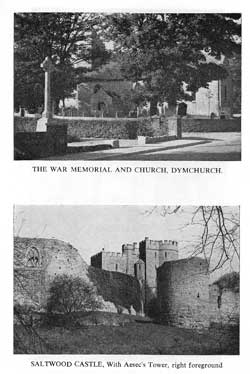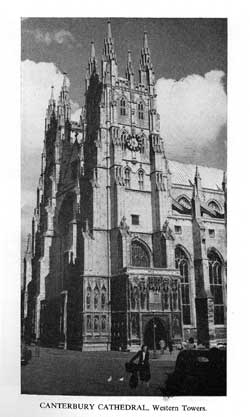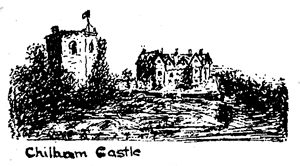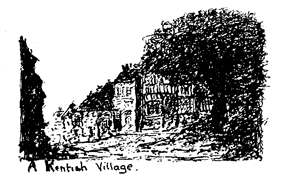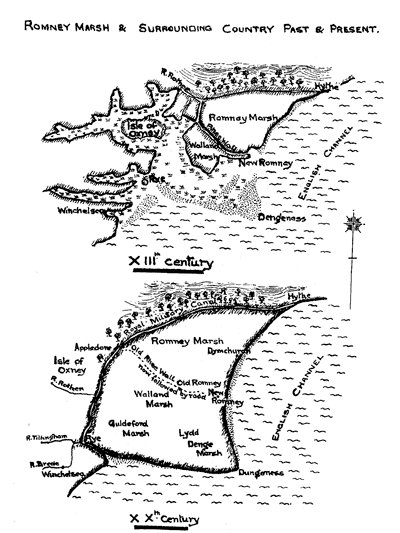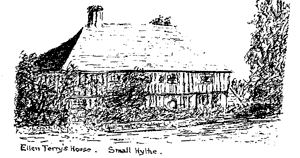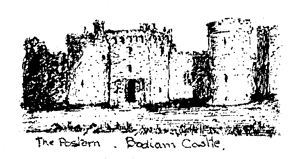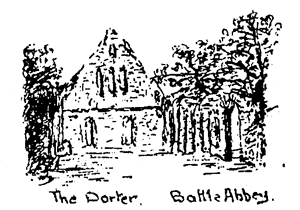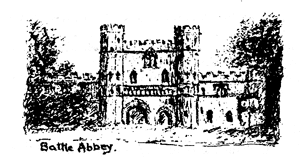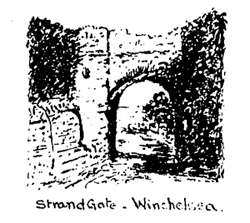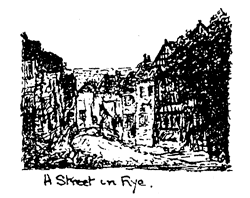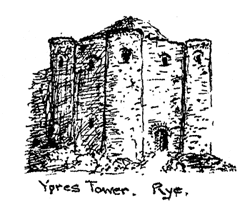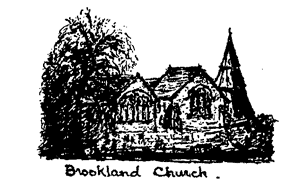 |
AROUND AND ABOUT Revised 1966 ITINERARY IDEAS A FEW WORDS ABOUT ROMNEY MARSH |
|||||
|
|
||||||
|
CONTENTS Marsh Frogs | Smuggling | Cinque Ports | Excursions | Dymchurch | New Romney | Hythe | Saltwood | Dungeness | Lympne | Folkestone | Dover | Canterbury | Chilham | Ashford | Appledore | Tenterden | Smallhythe | Bodiam | Battle | Winchelsea | Rye | Brookland | Lydd | References PART V
Chilham deserves a visit even if the visitor wishes to do no more than drive into the village pause a moment by the green, and drive on again. About nine miles from Ashford and seven from Canterbury, in the fork between the main roads from Maidstone and Ashford to the ancient Cathedral City of Kent, lies Chilham. The Pilgrims' Way passes hard by this picturesque XVth century Kentish village with its store of history reaching far back to long before the Romans came to our shores. Its name is derived from the Saxon Cyleham, supposed by some to be a corruption of Juliham or Julham, the village of Julius. Here it is said that Julius Caesar fought his battle of the River in 55-54 B.C., defeating the Britons and dislodging them from what was then known as their "fortified place." Here the Romans set up their Camp (Castrum) and subsequently fortified it raising its status to that of a Castle (Castellum). Now presenting rich examples of Old England, this pretty little village with its very fine XVth century church forms three sides of a square. On the fourth side lies the lodge and gates of the Castle, with its magnificent avenue of trees leading away to the country mansion which now occupies the place of honour once dominated by the earlier fortress. The present Jacobean house was built in 1616 by Sir Dudley Diggs, and looks out toward Julaberry Down, where tradition says under a great mound of earth lie the mortal remains of Quintus Liberius Durus, Caesar's tribune, who lost his life whilst fighting in the Battle of the River.
The layout of the garden and its beautiful bowling green are of great attraction. On entering the Castle by the main gate one walks up the avenue and around the terrace above the bowling green. Quite unexpectedly one finds oneself below the ancient grey walls of the 'keep,' still preserving austere command of the surrounding country. Here upon this site has stood a castle for two thousand years. Excavations have provided examples of Saxon and Roman work of great antiquity. The present tower has been built upon these age old foundations though the actual date of its construction is a little obscure. It certainly goes back to within a few years of the landing of William of Normandy on our shores and his victory against Harold at Senlac in the County of Sussex. It was at this battle that the Saxon Nobleman Sired who lived at Chilham, was killed fighting for King Harold. Thereafter his lands and estates were seized by the Conqueror and like many others were shared with his Norman followers. From the roof of the Norman Keep a magnificent panorama of the country extending to the sea may be had on a clear day. In the court yard near the entrance is the castle well, which for centuries has provided water to the many families who have resided both here and later in the house below. The well was operated by a donkey harnessed to a yoke and walking a never ending circulatory path turned a large gear wheel. This in turn revolved a crank shaft which raised and lowered the plungers of the three pumps in their barrels thus maintaining a good flow of water. The well is still in use, though the old time donkey has been replaced by an electric pump, and the clip clop of his hooves has given place to the rhythmic whirr of modern science. In the ground adjacent to the 'Keep' are some great trees of ripe old age and vast size. Amongst these are a celebrated Judas tree and a very old Mulberry, possibly the oldest in England and the last survivor of the many which once graced the gardens here. In the XVIIth century Colonel Diggs, a descendant of the builder of the present red brick mansion, whilst Governor of Virginia transplanted some of these Chilham Mulberry trees to an island in the New World, now known as Mulberry Island. The standard which flutters from the staff upon the 'Keep' bears the armorial bearings of the present owner of the Castle the Hon. John Skeffington, descendant of the Norman family of the same name mentioned in Domesday, and heir to the 12th Viscount Masereene and Ferrard. To lovers of England and English history Chilham is a gem of beauty and romance. It is easy of access though seldom seen. For those who pay their duty to Canterbury it is no distance extra to drop in at Chilham on their return journey. An hour at Chilham will live a lifetime. From here the drive home via Ashford is one of the loveliest in Kent. The way to Ashford leads across the Marsh. There are a number of routes of varying degree of attraction though possibly the most frequented of these is via New Romney. One, sometimes followed, leads through Newchurch and Kingsnorth and is strongly to be recommended, specially in early summer when the countryside is at its best.
To the young visitor there is little in Ashford to hold the attention beyond the Market and perhaps a prearranged visit to the Railway Works of the Southern Region of British Railways. Market is held on Tuesday each week and early closing is on Wednesday afternoon. By the kind permission of the British Railway Authorities, parties of School children may be shown over the Railway Works on certain days of the week. In this case, however, preference is given to parties who travel to and from Ashford by Rail. Parties are met at the works Main Gate at 1.10 p.m. and a full tour of the works occupies at least three hours. Applications for such visits should be made direct to:—
Turning to the westward we come on a glut of interest. Rye - Winchelsea - Tenterden - Smallhythe - Bodiam - Battle - Hastings - Brookland and Ferryfield, the aerial terminal of the cross-channel passenger and freight ferry service. A glance at the map will show that it is feasible to link many of these places together; according to the object of the visit, age of children and the time at one's disposal.
Taking a round trip the route leads away from St. Mary's Bay to New Romney and thence to Appledore along the ancient course of the river Rother as bound in more recent times by the Rhee Wall in an endeavour to keep it from wandering. We pass through Appledore, the only one of King Alfred's "burghs" to fall into the hands of the Danes, who plundered, pillaged and destroyed wherever they went. Priests were sacrificed on church altars and the fear of the Norsemen was a terror in the land, which it is hard to gauge in these XXth century times. From Appledore the road passes through very attractive country where hops are grown and the familiar 'Oast' house is very conspicuous in the landscape. Tenterden, with its beautiful XIVth century church, was once a port and is associated with the other Cinque Ports. It was in the XVth century a noteworthy centre of cloth weaving and many of the houses and buildings in this delightful old town have a direct connection with that trade. When at Tenterden it is but a couple of miles to the hamlet of Smallhythe and the country residence of the great British actress the late Dame Ellen Terry. This once flourishing little seaport with its black and white houses boasts an almost unique Tudor red brick church built in the XVIth century. To those in whose hearts is an affection for the arts, and particularly the stage, a visit to Ellen Terry's house is well worth while.
Continuing on our way to Bodiam we pass through the village of Rolvenden and after traversing some very narrow lanes drop down over the hill through wooded country to the river flowing lazily along through broad pasture where once the tide enabled ships to sail. Here stands the Castle of Bodiam. Bodiam Castle, dating from 1385, now but a shell, is a perfect example of a XIVth century stronghold, lending itself admirably as the setting for a mental illustration of mediaeval life in this country. The castle is situated on the north bank of the river Rother and is surrounded by a moat, which is crossed on the north side by a causeway; on this was formerly placed a barbican, of which some ruins still remain. This was an advanced work strengthened with a portcullis, and was of such size as to contain a sufficient number of men to prevent a surprise. It was also commanded by the entrance towers. Between the barbican and the castle was the drawbridge. The castle itself, which we now approach is nearly square, with circular towers sixty-five feet high at the four corners, connected by embattled curtains, in the centre of each of which square towers rise to an equal height with the circular.
The gateway is a majestic structure, composed of two flanking towers, defended by numerous oiletts for arrows, embattled parapets, and deep machicolations, whence stones and other missiles could be hurled on the heads of an attacking force. Immediately over the gateway are three shields, bearing the arms of Wardeux Dalyngrigge and Radynden. The ancestral arms were often placed over the principal entrance of a castle to denote the descent of the owner. Above this is the crest of the Dalyngrigges - a unicorn's head. A huge portcullis still frowns grimly over us as we enter a vaulted chamber, about thirty feet by ten. At the intersections of the groinings overhead are openings into chambers above, through which melted lead, pitch, oil, or water could be showered down on assailants below. The first door and portcullis being passed, there was another, half way through the passage, and yet a third, to be overcome before entrance could be obtained to the court yard of the castle. Having passed through the gateway, we perceive that the latter half of the passage supported a balcony. The southern side of the quadrangle, opposite, is occupied by the windows of the great hall, with passage leading to the Postern and the still remaining elegant windows of the buttery and kitchen. The whole court yard was surrounded by buildings usually of two storeys in height. Turning to the left as we enter the quadrangle we find a fine series of chambers, which were probably the apartments of the officers of the fortress, and one smaller, on the corner, which communicated with the north-east tower. These towers had each three storeys of hexagonal-shaped chambers. Proceeding southward, we next come to the chapel, which was lighted by a window of three lights over the altar (this still remains in a dilapidated condition) and probably by a larger one, looking on to the court yard. Next to the chapel comes the residence of the owner of the castle; the first apart- ments we enter are the bower and great chamber though the dividing wall has disappeared. They were probably the rooms in which Dame Elizabeth Dalyngrigge received her lady guests (circa 1390) and in which she spent her spare time, surrounded by her maidens, engaged in embroidery or other household 59 employment, which, with the lute and song, whiled away the hours. The principal sleeping apartments were on the first storey, and in the square tower, in one room of which are two curious stone cupboards, which were probably used for depositing deeds, jewels or other valuables. Beneath the bower and great chamber was a range of cellars. The private apartments of the lord of the castle were most probably located in the south eastern and round tower which has a groined basement. The great hall was a noble room, 40 feet by 24 feet, at the upper end of which was a small platform or dais, on which the lord and his principal guests dined. The roof was of oak, or chestnut and in the centre was a small turret or aperture to carry off the smoke from the fire which was placed in the centre of the floor on a raised hearth. The walls were covered with tapestry to about five feet from the ground. The principal entrance to the hall was at the lower end, where a space was parted off by a screen, extending the whole width of the hall, and supporting a gallery in which minstrels played during the feast. In the centre of the screen were double doors, communi- cating with the kitchen, buttery, etc. The buttery hatch consisted here of three arches, through which the viands passed from the kitchen to the hall. We now pass on to the kitchen, a fine room 18 feet square, with two huge fire-places, which no doubt blazed merrily on many a festive occasion. Between the great hall and buttery is an opening leading to the postern, access to which across the moat was originally by causeway long since destroyed. In a recess in the walls here is a newel staircase leading aloft to the battlements whence a good view of the surrounding country can be obtained. Leaving the kitchen at the south west corner we enter a hexagonal tower in which is situated the castle's well and water supply. The western side of the quadrangle accommodated the castle servants, in hall, kitchen, and other living quarters above. The northern face to the west of the gate was probably the castle stabling. In 1643 the castle was demilitarised by the parliamentary forces under Waller, after their capture of Arundel Castle - orders being given to dismantle and sell all the material pertaining to Royalists. Time, neglect and weather have produced the state in which we find the place today. There is an interesting museum on the high ground above the castle whence admittance to enter is obtained. From Bodiam the road leads on to Battle with its historic connections with William the Conqueror and the death of Harold at the battle of Senlac on the slopes above Hastings. The ruins of Battle Abbey are all that now remain to mark that once famous religious foundation where, tradition has it, fell the last of the Saxon line of Kings in his ill-fated but gallant attempt to withstand the last invader to set foot on English soil. The abbey church was pulled down in the early XVIth century. The abbey gateway is a most imposing edifice and gives entrance to the grounds where now stands a school, the buildings of which are not open to the public. The shell of the dorter and the foundations of the abbey church are all that can be inspected by the visitor.
In the gate house on entry may be seen a copy of the controversial document discounted by many and known as the "Roll of Battle Abbey." Upon this appear the names of many of those who accompanied the Conqueror and fought with him at Senlac field. An interesting document for which doubtless there is some authenticity though probably lacking to some extent in accuracy. The original, if indeed it ever existed, was probably lost at the dissolution of the monasteries when many valuable documents disappeared. Certain it is that those whose names appear thereon came to this country at that time, though others there be that lay claim thereto whose names are absent.
If short of time a brief halt at Battle in the centre of the town will enable all to be seen that will leave a mark on the young mind to be made, which may well stick fast whilst a longer and more tedious tour of the ruins might only serve to mark the occasion of the visit as one of those more boring of excursions. To those on pleasure bent let me send you on your way to Hastings, there to drink your fill of "ginger pop" and stuff your cheeks with "rock" to the garish music of roundabouts and fairs, only to return the poorer with that glorious satisfaction of youth of having had a lovely time!! Should any one desire to include Hastings in one of these tours, as well one might, it should be the last place to be visited before returning, despite the fact that the homeward route leads through such interesting places as Winchelsea. Rye and Brookland to say nothing of Lydd and Ferryfield. These may be described in the order in which one passes through them for convenience. Standing on high ground and once a thriving port now stands the little town of Winchelsea in the most delightfully peaceful setting. The church immediately calls attention to itself by virtue of its unique shape. All that remains today are the chancel and eastern chapels of what must have been a very large and beautiful edifice before its sack and destruction by the French during one of their frequent raids on this coast in the XlVth century. The town and ancient borough are full of attraction and possess several fascinating 'period' houses.
The church is worthy of a visit if only to see the extent it once occupied. It is very much darkened by its number of stained glass windows. On leaving Winchelsea one passes through a very picturesque gateway which lends a poetic setting to the picture of the middle ages which we are about to enter. This is the "Strand" gate and gives out on the open country of Petts Level with Camber Castle and Rye in the offing. It was built about the thne of King Henry V who was alert to the need for defending our Southern coast against the possibility of invasion from the continent. Camber Castle is a ruin lying to the right of the road and dating back to the same period. We are now on our way to Rye over a rather uninteresting stretch of open country, once, not so long since, a wide expanse of reeds and rushes and rivulets which ebbed and flowed with the tide.
Our attention is arrested by a conical shaped hill surmounted by a crenalated building. Around the base of this hill on the one side rise the masts of boats and small ships, whilst on the other the rooftops slowly merge into the trees of the slopes of the long fringe of highland which, in centuries agone, was a headland jutting out into the sea, with Rye like a football at its toe. Over the ages the land has formed and developed until today we find this ancient Cinque Port at the head of the tidal estuary of the River Rother, some three miles from the coast.
Entering the town by the docks over a level crossing we may take a circular tour around the hill. As we pass under the cliffs we can still see plainly the incursion of the waves which once beat upon them, threatening the safety of those who lived above. Following this road round we enter the fortified borough and Cinque Port of Rye. This town is like a history book, illustrated on each page with living pictures. Just allow one's imagination a little scope and immediately one is back three hundred years as one turns the corners of the narrow streets, and wends one's way over the cobblestones. Each house abutts its neighbour and no two are precisely similar in design, and yet they all blend in together to make scenes such as one associates with old England and Christmas cards. Sacked three times in the XIVth century by the French with its church burnt to ashes and many of its inhabitants carried away captive, we can well appreciate the meaning of such names as Watch Bell Street.
Amongst the most interesting buildings to see are the Church, Ypres Tower and the Mermaid Inn. In the West Street stands Lamb House, the Georgian home of the author and novelist Henry James who lived there until his death in 1916. Another attraction is the Rye Potteries, the proprietors of which are pleased to show parties of children over by private appointment. The fascinations of Rye appeal to young and old alike, with especial force to those of an artistic temperament or who are fond of hearing and seeing how our forebears used to live. Leaving this period piece we cross the Rother to find ourselves on Guldeford Level as we approach Walland Marsh, on our way to Brookland. A glance over one's shoulder leaves an unforgettable picture in one's mind of a city on a hill, girt about with battlements, and full of tales of long ago. Soon we pass East Guldeford with its lovely farmhouse by the roadside to the village of Brookland with its unique church and spire separate from the main building. There are many stories about this XIVth century church, such as the one that there once lived an elderly spinster in the village when the church boasted a steeple. Noted for her great piety and regular attendance at church', one day the lady promised her hand in marriage to a sweetheart of many years standing. The shock to the old church (so goes the yarn), was so great that the spire fell down. And so, another good man went west! The fact of course is that the land is so very low-lying and foundations of sufficient stability could not then be laid to carry the weight of a bell tower. Accordingly a wooden structure was built nearby for the purpose. Cardinal Wolsey was once rector of Brookland and much is probably owed to his generosity after his rise to fame. In the church are the measures, scales and weights used for measuring and weighing in the tithe according to biblical custom and precept as followed by the church for many centuries.
There is also a unique Norman leaden font depicting upon its outer surface the signs of the Zodiac and the labours of the months. The most direct route back to Camp from Brookland is by way of Brenzett and St. Mary-in-the-Marsh, a winding way across the Marsh with the sun behind one. Should your interest be aroused by a most conspicious square tower standing out against the sky line then you should direct your course towards the ancient borough of Lydd. The church whose tower is seen far and wide over Walland and Denge Marshes from Rye to Romney was badly damaged by enemy action during the 1939-45 war and though partially restored still bears many scars. Cardinal Wolsey was at one time rector of this living. Lydd which gives its name to a certain type of high explosive has little to commend it to the passer by. It is wind- swept and the soil is poor and shingly and accordingly for years has been the home of artillery and explosive experimental trials. There is a large military Camp here. IN CONCLUSION No attempt has been made to produce a guide book or comprehensive directory to all that can be found on Romney Marsh or in the surrounding country. It is however hoped that this will be of some material assistance to those who may contemplate coming to this area for the first time. The following few lines give the lilt to what may perhaps appear dry and prosy and produce the true Marsh music for this corner of Kent.
|
||||||
